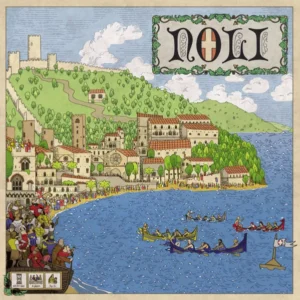Noli Board Game Review

By MARK WILSON

Year Published: 2022
Players: 2-4
Playing Time: 45-60 minutes
Noli is a tragedy for me. Its mechanics seemed to embrace the type of fun I appreciate in games, and it came endorsed by a couple others whose recommendations for me are generally quite reliable.
Instead, it fell profoundly flat. This review is a story of how sometimes a game isn’t greater than the sum of its parts, but less.
Noli: The Premise
You’re a prominent family in a fishing village, trying to gain the most influence by building the tallest tower. But you have to compete for fish, money, and avoid having your tower toppled by the crash of waves.
Apparently you weren’t smart enough to build far from the shore, and the infrastructure people can’t build a sturdy wall to save their lives. Such is the hardship of being a rich family in an obscure fishing town.
Noli plays out over a series of rounds, each with set phases. You have a blind auction for four different possible boons, each relating to the game’s later phases.
These auctions, they’re brutal. You lose your money regardless of whether or not you win them.
You can acquire additional fishing boats, which will net you more resource/ability cards in the round’s final harvest phase. You can push a meeple up a track that acts as a game clock and also tiebreaker for auctions, which can be crucial in winning close auctions that bring with them vital advantages.
And you can earn the right to “bank” a die (or more than one!) for the game’s most chaotic phase: that of real-time rolling of dice as you frantically try to get them all to land buoy-side up. Finishing before opponents nets you more lucrative piles of resource cards.
It’s amusingly punitive, swingy, kinetic, and doesn’t seem to take itself too seriously, nor does it last too long. Games generally last about 45-60 minutes. So far, so good.
The Downside of Brutality
So you lose a couple auctions in crushingly close fashion, meaning you’re out of money and have no boons to show for it in later phases. Then you roll poorly, get the fewest resources, and the 2nd round begins…
Then it happens in a 2nd round, particularly because you have less of everything to bid and roll with. The 3rd round begins and you start to get a sinking feeling in your stomach…
Now you have less money to win anything and you’re behind on boons. And what’s the catchup mechanism for this? There isn’t one. Your only option is generally to put all your money into a single auction slot, hope you win that auction and start to roll better, and slowly climb back to relevance.
And if you think about possibly banking two round’s worth of money to do better in auctions, it’s quite possible to have your saved money wiped out entirely during the resource phase by a random card ability. So much for long-term planning, eh?
The “slow climb back to relevance” plan can absolutely work. Or it can backfire and dig you into a deeper pit. Past a certain point, the pit is too deep to conceivably climb out of before the game ends.
I’m all for brutal beats and swingy mechanics, but context matters. And the context in which I usually embrace those elements is where players have believable means to affect a dramatic comeback. Often it’s where other players will ignore whoever’s behind out of necessity and focus on the leader(s), allowing whoever had the bad early luck to make unhindered progress for a while.
Here there’s none of that. You are incentivized to keep a downtrodden player in the dirt, pushing them deeper into the mud with each passing round. The game appears to assist in this effort.
Some of the game’s fans, including some I’m friends with, have stories of dramatic comebacks and tightly-fought sessions. These are possible too.
But I took the time above to recount that hypothetical session because it’s happened in my games a lot. As in, the majority of the time.
Sometimes 2-3 people are able to compete and it’s just one person who has a wire-to-wire slog wherein they are never even remotely relevant. Other times it’s a single person who rides an early wave of fortune to an unassailable lead. So occasionally it’s competitive, but that isn’t assured, and it’s always been bad for at least one player, due to forces they can’t really control.
This problem is more pronounced with three players compared to four. At three, there’s more chance that one person will turn a minor edge into an overwhelming lead. At four, the problem is less pronounced but can still crop up.
In the worst sessions, we actively discussed ending the game early. 45-60 minutes doesn’t seem like a long time in board game parlance. But it can feel interminable when you feel helpless after the first 20 minutes or so, and despite your best efforts in the remaining rounds, this feeling ends up proving true.
The Table Reaction
I’m a gamer who derives a lot of enjoyment out of the general enjoyment of others at the table. To a large extent, the group’s fun is my fun. So this game has been a nightmare.
If I could ignore the reactions of others and just be in my own world, I might be able to laugh at Noli’s gameplay before moving on. Instead, I’ve often found myself in sort of an “emotional damage control” mode, trying to keep the spirits of everyone up and commending them on their perseverance through such bad luck.
After nearly every session I played of Noli before selling it, at least one player told me outright that they’d never play it again. For clarity, no one lost their temper; they all had a healthy, bemused perspective about the experience. But this sardonic amusement was only due to the knowledge that they were never going to have to play again.
By the last session I had forced myself through, I was sharing the sentiment that I never wanted to play again.
Even the good friend I referenced earlier, the one who enjoys Noli, has noted that it’s an extremely polarizing game among people he’s introduced the game to. My comments are not the only of their kind; the game’s Board Game Geek page is lined with comments pointing out the same flaws, even as some find ways to enjoy it for these things.
Noli – Conclusions
Why did I force myself through more sessions after I’d seen this a handful of times? Because Noli’s gameplay is, at least in theory, legitimately novel and infused with creative design decisions.
The real-time phase feels like an exuberant, playful choice for action resolution, and the zero-sum outcomes of the auctions seem to incentivize nuanced doublethink and tactical bidding. These are elements I normally enjoy in games.
I wanted to love it, and wanted to give it enough chances to earn that love.
But the execution of an idea matters; the idea alone isn’t enough to carry a game.
I’ve mentioned some positive voices to point out that mine is not the only opinion on the game, but also noted that I’m not the only one to see the game in this light. Maybe you’re among those who’d love it; I can’t say. But I thought I would be when I first purchased it, and so hopefully this can act as a cautionary hedge that will prepare you in case it doesn’t work out for you either.
Also, the box cover art is gorgeous. Gotta get that in here before I wrap up. I’d happily frame a painting of it. But with that said, let’s land this sputtering plane.
Noli is a lovely series of ideas that somehow combined to produce some of the most lamentable gaming of the past few years for me. I want to laud it for its ambition and creativity. Instead, I have to write this review. If I ranked games based on table reaction alone – including my own and those I’ve played with – it would be in the bottom 1% I’ve ever played.
…
Like my content and want more? Check out my other reviews and game musings!
Read More From BTD
Recent Posts
Categories
- All (350)
- Announcements (4)
- Board Games (203)
- DMing (28)
- Game Design (16)
- Playing TTRPGs (22)
- Reviews (189)
- RPGs (142)
- Session Reports (91)
- Why Games Matter (9)